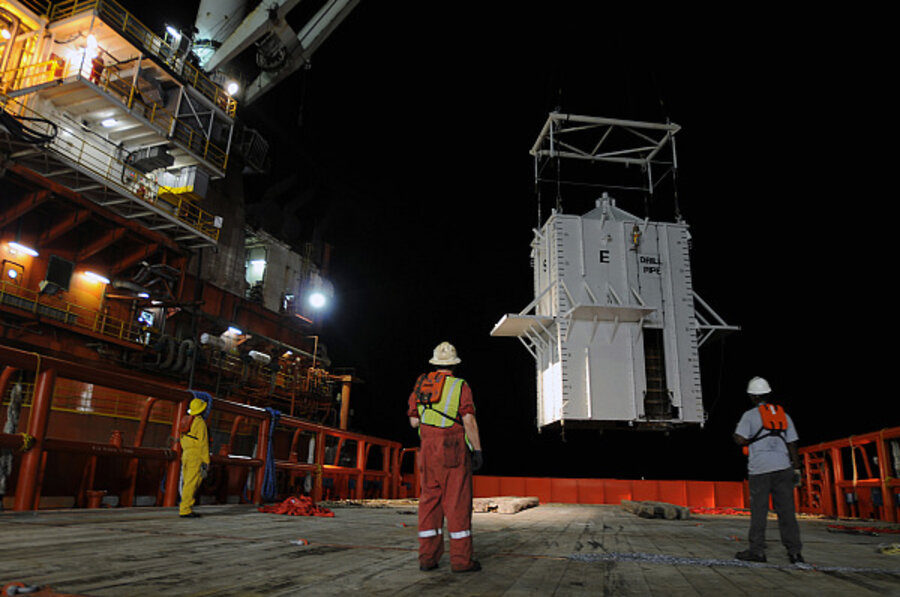Tricky maneuver: Will containment cap stop the BP oil spill?
Loading...
| New Orleans
Louisiana and the Gulf region are holding their collective breath as crews in the Gulf of Mexico attempt to staunch the flow of the blown Deepwater Horizon oil well head with a containment cap.
Using a crane to position the 100-ton, four-story-tall, concrete and steel box over the well, the operation is the first to attempt such a containment strategy at such a great depth. Working a mile beneath the surface of the Gulf, underwater remote vehicles will fine tune the final position of the box over the well head in the BP oil spill.
If successful, the containment box would begin funneling as much as 85 percent of the oil plume into a pipeline pumping the oil into a barge on the surface as early as Sunday.
IN PICTURES: Louisiana oil spill
“The schedule is fluid and changing,” said BP spokesman Mike Abendhoff. “They’re being extremely careful but want to get it done. You really only get one shot at it.”
The containment effort at the well head comes as dozens of boats across the Gulf region work to keep the giant oil spill from coming ashore. Efforts include setting fire to the densest concentrations of the oil, dousing the slick with chemical dispersants, and laying thousands of feet containment boom.
Experts experienced with previous giant oil spills are skeptical about both efforts. Rick Steiner, an Alaskan oceanographer who worked for years on cleanup after the Exxon Valdez oil spill, spent yesterday observing the slick along the south Louisiana coast by private boat and plane.
“Out of 40 boats I saw dragging or deploying boom, about three [boom] actually seemed to be containing any oil,” says Mr. Steiner. “This oil is so thoroughly mixed with water that it’s just going right under the booms.”
Getting dome in place very difficult
In theory, a containment box could corral oil spewing from the well head, but placing one correctly at such depths is exceedingly difficult, says Jerome Milgram, an ocean engineering professor at the Massachusetts Institute of Technology in Cambridge.
“A similar box was tried at the Ixtoc I platform, but they were never able to get it positioned correctly and it never really worked,” says Dr. Milgram, who served as a consultant on the oil spill disaster off Mexico in 1979. “Ultimately the only way it was stopped was by drilling a relief well, which took several months.”
The positioning operation in the Gulf began late Thursday night and may be completed later Friday.
“We have lowered the cap to around 4,000 feet and once we have it in place will start construction of the collection pipes,” said BP spokesman Curtis Thomas. “We hope to have it operational by Monday. You’re dealing with 5,000 feet of water and very dark and cold conditions and using remote devices so you can see what’s down there. It’s a very delicate process.”
Containment caps have been used in several oil well blowouts over the past 30 years, but extreme conditions greatly complicate this operation.
To succeed, the BP crew must contend with wreckage around the well head, the possibility of ice clogging the pipeline, a dangerous mix of oil, gas, and water that could explode, and intense fumes from the giant surface oil slick surrounding the work boats.
BP is also drilling a relief well that would shut off the blowout at its source deep in the seabed – an operation that will take months. The company is working on a third operation that would plug the blown well head from the top by encasing the failed blowout preventer with mud and concrete.
Both BP and federal officials have remained cautious in assessing the operation’s chances of success.
“I hope it works, but we are still proceeding as if it won’t,” Homeland Security Secretary Janet Napolitano said during a visit to Biloxi, Miss., Thursday. “If it does, of course, that will be a major positive development.”
Mixing oil and water
Steiner, the oceanographer from Alaska, says the slick floating in the Gulf will be very difficult to contain because the oil has so thoroughly mixed with seawater.
“The well is a mile deep and under great pressure, and much of the oil has been absorbed into the water column once it reaches the surface,” he says. “It’s also 50 miles offshore, which means it has a lot of time to be hit by waves and wind and sunlight, and is also being hit with chemical dispersants. What you’re looking at is a toxic plume of oil dispersed through the water column that is moving with the current. There may be no effective mechanical means of removing the oil.”
At the moment, the ecosystem of the Gulf’s deeper waters is at greater risk than the shoreline. The oil would at first attack the lowest end of the food chain, polluting single-cell organisms and tiny bottom-feeding creatures before affecting large organisms that feed on them.
“Polynuclear aromatic hydrocarbons such as this can also be toxic to marine eggs, larvae, and juvenile fish at one part per billion,” says Steiner.
IN PICTURES: Louisiana oil spill
Related:





